11 Important Elements to Include in Your Employee Handbook

In most roles I’ve begun, an employee handbook was the first internal document I read. So naturally, I’d make a lot of assumptions about the kind of place I was hired at based on the employee handbook.

From vacation policies to dress codes to nondiscrimination policies, employee handbooks have given me a clear overview of the dos, don’ts, regulations, and expectations of my new role.
They’ve also helped pique my excitement, especially when the company mission, values, and culture are laid out.
Below, I’ll cover the importance of an employee handbook, nine essential elements to include, an employee handbook template, and examples to help guide yours.
Table of Contents
What is an employee handbook?
An employee handbook is an exhaustive document outlining an organization’s policies, procedures, and employee expectations.
It’s a crucial resource for new hires and existing staff. Employees can overview their rights and responsibilities as members of the company.
Why is having an employee handbook important?
Employee handbooks are essential for several reasons, for both the employer and employees. Here’s why.
1. Inform new hires.
When I was hired at Paramount, I underwent a two-day orientation and onboarding.
During this period, I received an employee handbook that outlined staff expectations. That document included ways to promote privacy, harmony, safety, and community.
The handbook was a helpful resource for better understanding Paramount’s culture and how I could be an upstanding member of such a large, global organization.
It was also a relief to know this was a guide I could continuously refer to whenever questions or concerns arose.
2. Document mandated policies.
Paramount requires us to complete several regular employee trainings, including anti-sexual harassment, anti-discrimination, business conduct, and more. These trainings coincide with federal, state, and local laws that companies must uphold.
Employee handbooks are a great place for companies to outline these policies to ensure all staff are given the information they need and that employers comply with laws and regulations.
3. Declare company goals.
Most successful companies have cohesive vision propositions, mission statements, and values that provide context for the company’s purpose. These statements also guide employees toward a shared goal.
Modern employee handbooks include this information to guarantee all workers are immediately made aware of why they were hired and how they can play a role in the greater vision.
Reading this information in my employee handbooks also helped me grow enthusiasm and passion for my upcoming work.
What to Include in an Employee Handbook
Knowing where to begin is difficult when crafting an employee handbook. Check out the sections I have found most useful.
1. Introduction to Company and Values
As mentioned, I’ve found a lot of value in better understanding the company from an internal lens in an employee handbook.
While Paramount has a lot of externally-facing information, employees will get an inside scoop on what makes it so special.
This is a great way to begin the employee handbook, offering new employees an elevator pitch about why the company matters and why they should be excited to join it.
2. Code of Conduct
Here, I learned about the ethical standards and professional behavior expected at the company. It’s helpful to have a baseline of what the company expects of me ethically so I can remain an upstanding member of the community.
I’ve also learned a lot of basic employee-wide guidelines, such as hybrid office requirements and the dress code.
Overall, the code of conduct shares the company’s values and desired behavior that it wishes to foster in employees of all levels.
3. New Hire and Separation Policy
As a new hire at Paramount, I had endless questions about my new employment, particularly how and when to enroll for benefits. This section provides information about that, as well as more serious topics such as disciplinary systems.
In tandem, it provides information in case an employee wishes to depart the company for whatever reason.
Workers who don’t feel comfortable asking certain questions before announcing their leave can refer to the employee handbook to understand when their insurance coverage ends and if they will be paid out for unused time off.
4. Performance and Career Development Policies
Forward-thinkers like me are always planning for what’s next. When I start a new role, I want to feel confident that I’ll join a team that prioritizes my learning and career growth.
This section is a great place to lay out how promotions and raises occur, and what opportunities the company provides for employees to broaden their knowledge
5. Compensation and Benefits Policy
This section has been extremely vital to me as a new hire and long-standing employee.
It’s a great place to refer back to whenever I want to remind myself about my insurance coverage or sign up for a new program like tuition reimbursement.
It’s also where I go to understand my compensation. New hires will likely have questions about how they’re paid (weekly or bi-weekly) and how their payroll deductions look. It’s important information to have readily available.
6. Leave Policy
I’m grateful to work on a team and at a company that encourages me to take time off for vacation, sick time, and personal days. I learned a lot of this information in the employee handbook.
Since I’m not a salaried employee, the handbook explained how many PTO and sick days I received per calendar year, as well as what federal holidays the company observes.
It’s helpful to be able to refer back to this guidance when planning vacations and future time off.
7. Equal Employment and Nondiscrimination Policy
As a young woman of color, working at a company that recognizes the importance of diversity and inclusion is an absolute priority.
I pride myself on working for a team with all kinds of people who have diverse perspectives, which makes our work stronger.
I believe all companies should highlight these policies in their employee handbooks so new hires know from the get-go that the company is serious about who it wants to contribute to the culture.
8. Computers and Technology Policy
Many companies like mine have embraced a hybrid work environment, meaning we go into the office a few days a week and work remotely the other days.
For this reason, employees at my company receive company-owned devices, such as laptops and phones.
This can lead to many security and privacy issues, so I recommend including a section in the employee handbook that communicates regulations around using company-owned devices and programs.
9. Health and Safety Policies.
My company conducts bi-annual fire and safety procedure walkthroughs with security. However, as a new hire, I was eager to know these protocols from the start, since I had just missed the last round of walkthroughs.
The employee handbook is a good place to detail security procedures, such as requiring badges for entry and protocols in the case of emergency events, such as a fire.
This also helps reduce company liability by ensuring this important life-preserving information is provided to all new hires.
10. Non-Disclosure Agreement and Confidentiality Policy
One of the perks of being at my company is being privy to data, information, and plans that are not for the public eye. But with this opportunity comes a big responsibility to preserve the confidentiality of this knowledge.
Therefore, it’s essential to clarify in the employee handbook what is considered confidential information for internal operations and clients and how to maintain privacy to ensure it’s not misused or shared externally.
11. Signature Page
The most important part of the employee handbook is when employees actually agree to all the policies, procedures, and systems laid out.
This ensures employees read and agree to the terms of the handbook and that the company is protected in the case of a wrongful termination lawsuit.
Now that I’ve conveyed the areas I’ve found valuable in my employee handbooks, let me share a template that dives more deeply into what to include in each section.
Employee Handbook Template
Employee Handbook for [Company Name]
Introduction to Company and Values
Describe the company’s history, including when, by whom, and why it was founded.
Lay out the company mission statement.
Include insight into the company culture and what elements are prioritized in the workplace, such as autonomy or continuous education.
Code of Conduct
Offer a general overview of ethics and compliance, which allow the company to fairly regulate and assess an individual’s behavior.
Detail important policies, including tardiness, dress code, and disciplinary actions.
Provide resources for employees to reference when encountering ethical predicaments.
New Hire and Separation Policy
Let new employees know whether they need to wait to receive their benefits (and how long) and what steps to take if an employee wants to quit.
Outline the progressive discipline policy, which is a structured approach to addressing employee misconduct or performance issues using increasingly strict steps that allow employees to correct errors.
Summarize what benefits employees are entitled to and for how long, if terminated.
Performance and Career Development Policies
Lay out the employee evaluation process and at what cadence these reviews should be set up with managers.
Explain when and how promotions happen, as well as training and learning opportunities.
Compensation and Benefits Policy
Detail critical benefits regarding health care, dental, vision, life insurance, and stocks.
Share information about other employee benefits, such as tuition reimbursement, commuter benefits, parking, employee referral bonuses, and 401(k) plans.
Provide guidance regarding compensation, such as total salary, payroll deductions, and compensation increases for specific job descriptions.
Document the payment schedule for each employee (weekly or bi-weekly).
Leave Policy
Share how much paid and unpaid vacation time employees receive.
Clarify policies around sick time, medical leave, and paid family leave and ensure these comply with U.S. Department of Labor laws, if applicable.
List company holidays.
Equal Employment and Nondiscrimination Policy
Include an employment and nondiscrimination policy, per The U.S. Department of Labor Equal Employment Opportunity law.
Reiterate to employees that discrimination or harassment won’t be tolerated in the workplace.
Computers and Technology Policy
Relay what employees can and can’t do with their provided technology.
Inform whether the company has the right to view emails sent on company computers, if social media should be avoided on these devices, and how much privacy they should expect while using company property.
Share if any actions performed on company technology are fireable offenses.
Health and Safety Policies
Outline workplace safety guidelines, such as badge usage, guest policies, and prohibited items.
Relay vital emergency procedures in the event of a fire or security lockdown.
Let employees know their rights as administered by The Occupational Safety and Health Administration (OSHA).
Non-Disclosure Agreement and Confidentiality Policy
List what information employees must keep private, such as the company‘s internal business plan, client information, and employees’ financial account information.
Share ways employees can ensure privacy and confidentiality, such as avoiding public wifi, never leaving company devices unattended, and requesting NDAs from partners before sharing documents.
Signature Page
Include a signature page at the end of the employee handbook that states the employee has read and agreed to the information detailed in the employee handbook.
If you’d like an even more seamless, plug-and-play template, check out HubSpot’s free employee handbook template that offers a foundation to integrate your brand’s personalized messaging and information.
Sample Employee Handbook
I recommend you create an employee handbook that’s unique and particular to your culture and company values.
However, I’ve developed a sample employee handbook to help get you started. I open with a company overview and information about the business’ values.
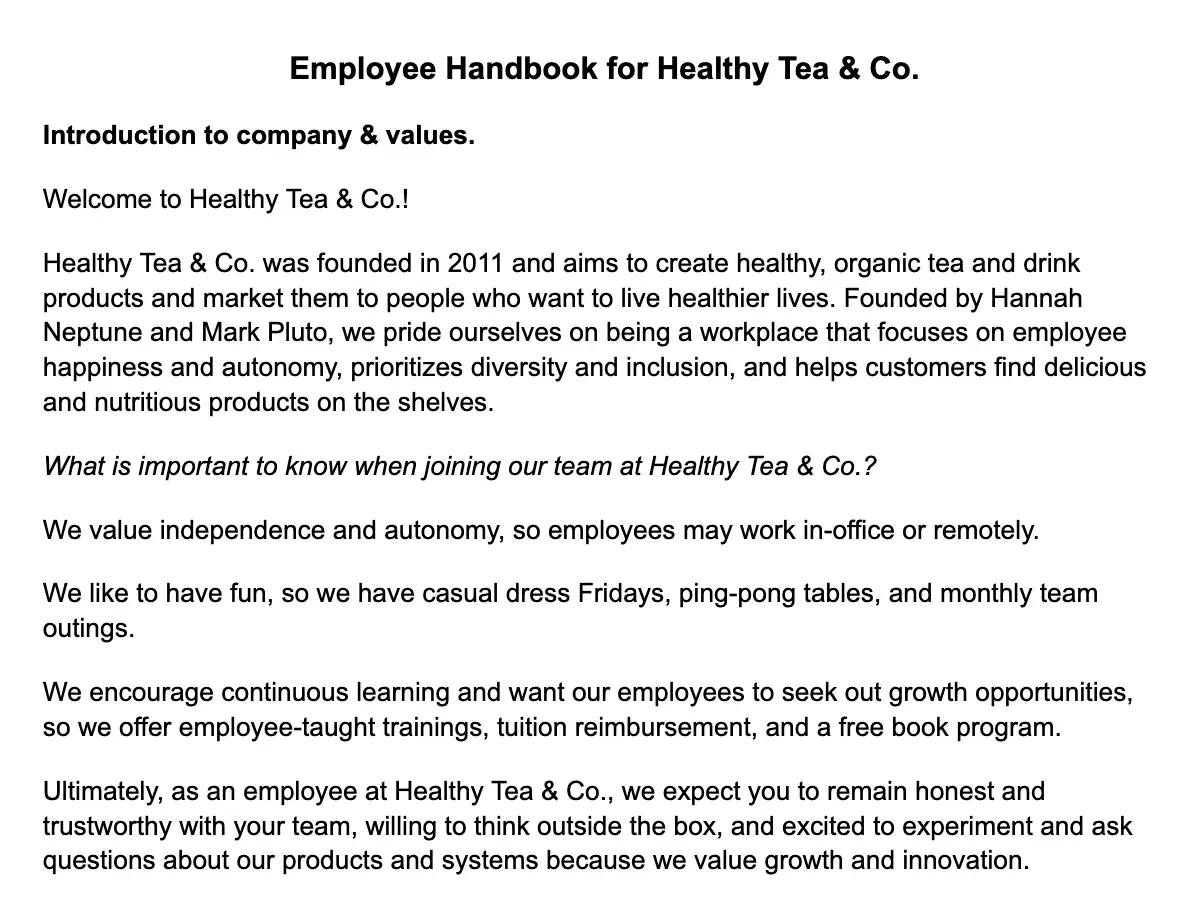
Many sections are too personal and legally sensitive to include in a sample.
For instance, review state and federal laws and contact a lawyer when writing a non-disclosure agreement. After the intro, I recommend adding information about your culture code. Then, you can talk about specific policies.
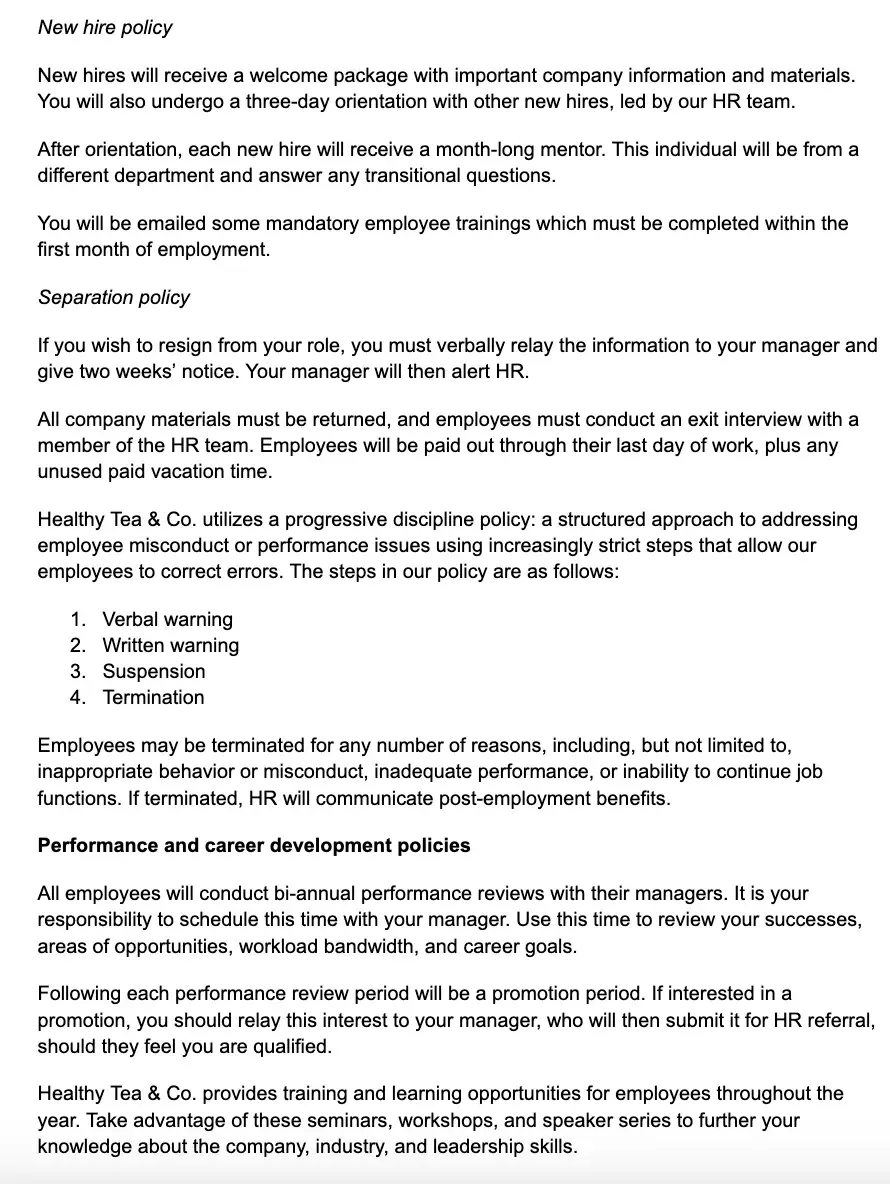
After this section, I recommend listing out any relevant employee benefits. That includes their compensation, benefits, and paid time off.
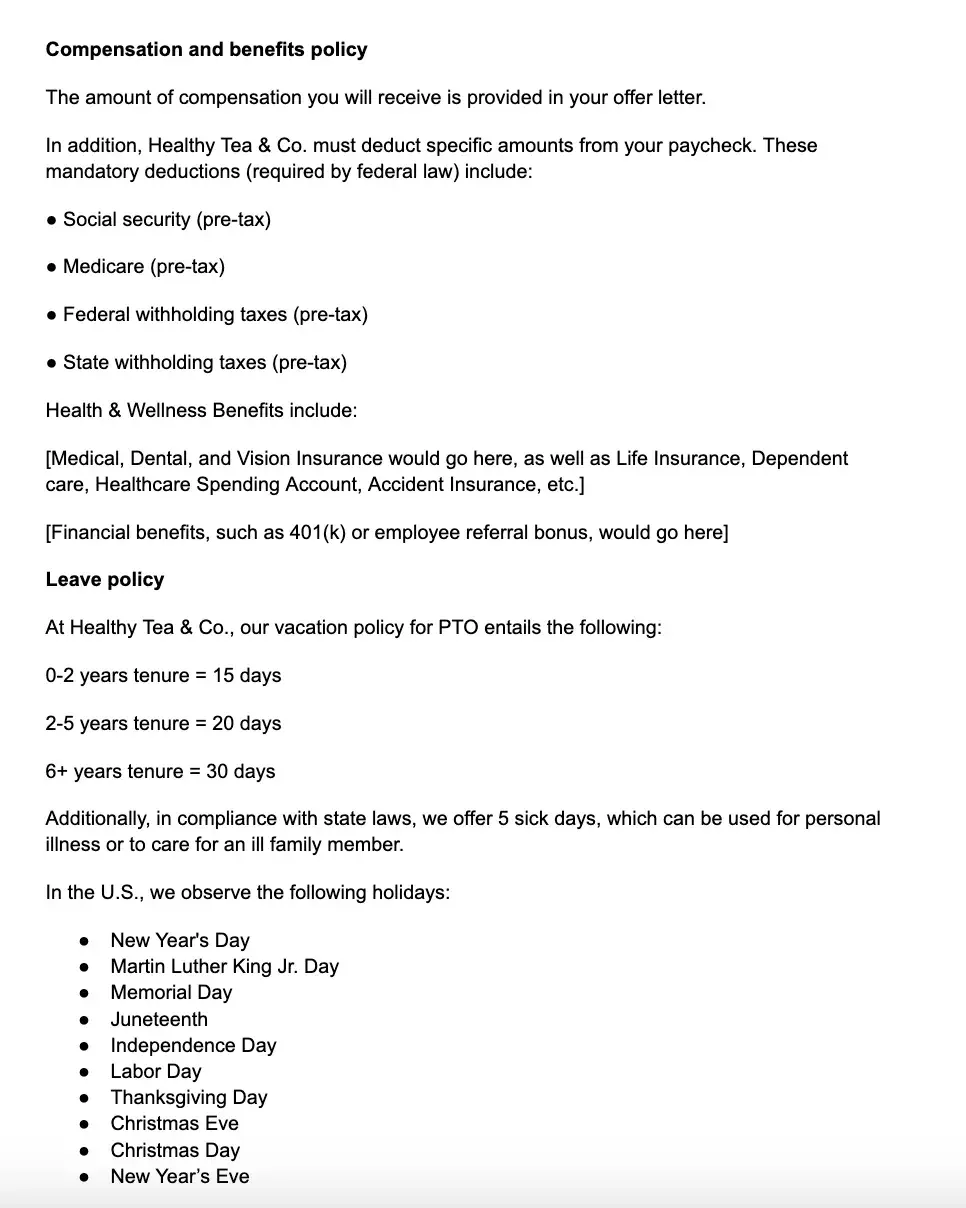
The last portion of my sample handbook features bracketed sections that relate to government regulations. If this were my business, I would include that information then ask for an employee signature.
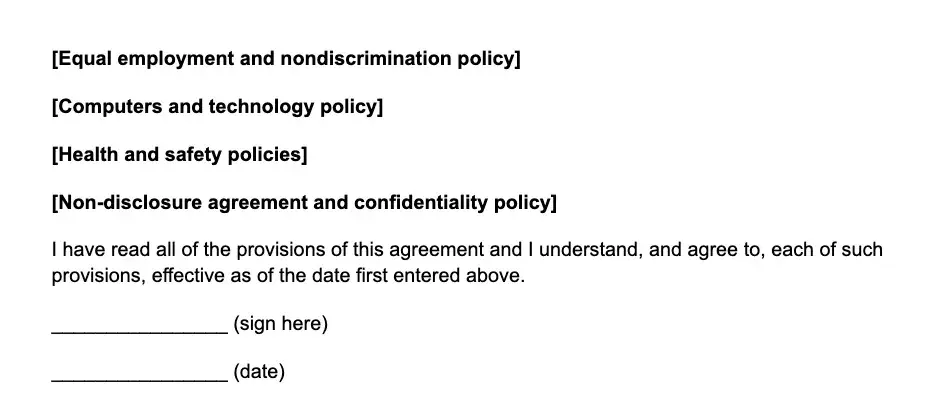
Employee Handbook Examples
I’ve established that several sections in an employee handbook are fairly standard — not to mention legally required. Additionally, many policies are for internal eyes only, making them inaccessible to curious blog writers.
Therefore, I’ve gathered a list of creative, unique culture pages, books, and codes.
These are terrific ways to begin an employee handbook. They go beyond a traditional company history and overview to embrace bold design, humor, and imaginative language and accurately portray the company’s culture to new hires.
Of course, these examples are not standalone employee handbooks, but take a page out of these brands’ books to jazz up an otherwise mundane, standardized document.
1. Warby Parker
Warby Parker is a fashionable, affordable eyewear brand from whom I’ve purchased one too many pairs of eyeglasses. Its culture book is designed as a digital guide, representing its stylish, innovative brand qualities well.
I especially love the aesthetically pleasing color scheme, soft fonts, imagery, and sense of humor.

While I’m interested in a company’s origin, I don’t necessarily want to read a lengthy history book about it.
Warby Parker does a phenomenal job of keeping its history short and easily digestible by designing the origin story as a text conversation and the history as a visual timeline.

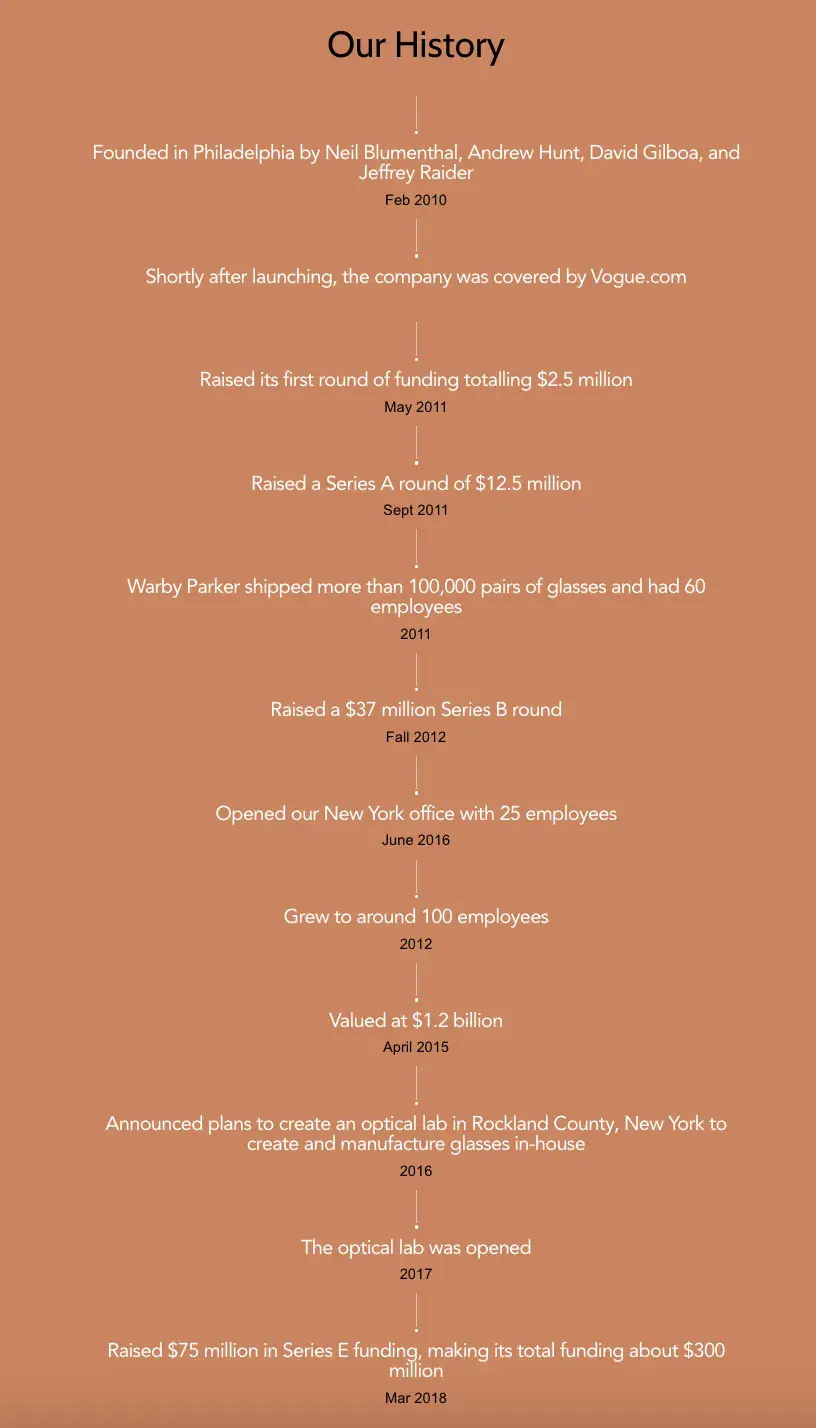
Lastly, I love the emphasis on the company values, framed as “Our Promise.” This shows that these statements aren’t just things the brand values and hopes to accomplish but vows to.
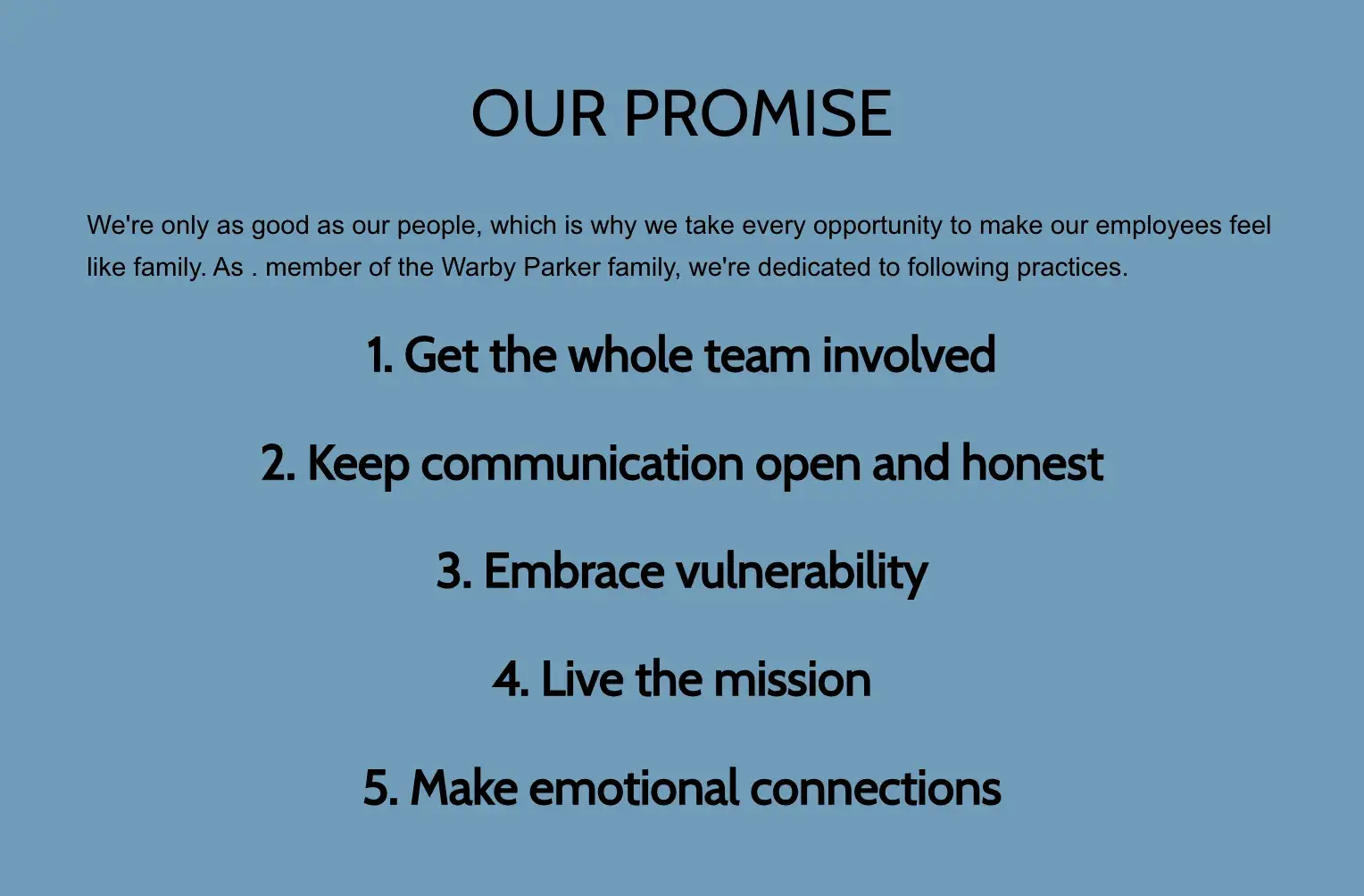
If I were an employee at this company, I would feel confident that this is a place that encourages creativity, doesn’t take itself too seriously, and prioritizes the well-being of its workforce.
2. Netflix
Netflix’s culture page is a great example of how a brand can personalize its employee handbook for potential, new, and long-time hires.
While an employee handbook has a lot of important, mandatory information, it can also excite employees.
Unlike Warby Parker, this page has a crisp and clean black-and-white design. However, I think this works well with the language used. It’s a sincere and honest ode to the culture they have and aspire to have.
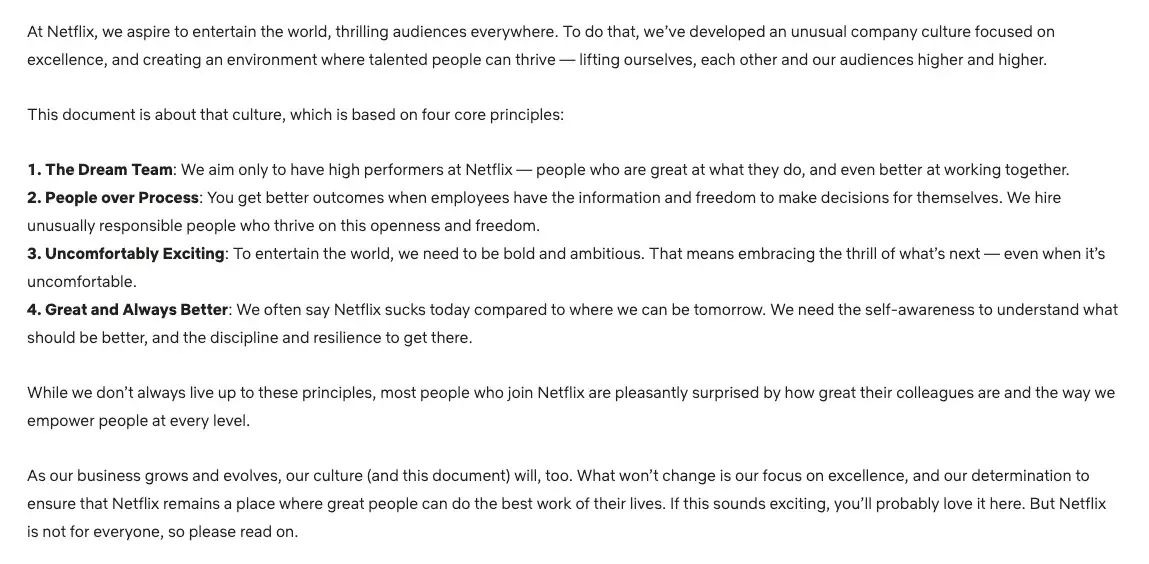
I love the above introduction, as it authentically reveals what Netflix prioritizes in its workforce while admitting that it sometimes falls short of these goals and is a work in progress.
As a new hire, joining a company that prides itself on perfection is intimidating, so it’s a relief to know you can be a part of the continuous growth.
Below is a snapshot of how Netflix outlines its rules, without getting too into the weeds (that’s for internal, hired employees).

I appreciate this section because it calls out that there are strict rules for essential policies, such as harassment and privacy.
But then, the brand personalizes by stating some of their less serious policies, such as “Take vacation” being their vacation policy, and “Act in Netflix’s best interests” being the expenses policy.
Language like this gives important information while offering context about the company culture. There is a way to be serious about serious matters and playful about the fun parts of an employee handbook.
3. HubSpot
Not to toot our own horn, but the HubSpot Culture Code is pretty great.
One of my many favorite parts is that it’s in a slide presentation format. This makes it feel less daunting and more accessible to flip through on occasion, rather than digging through a lengthy document.
I appreciate that HubSpot recognizes the Culture Code as more than just an employee handbook — it’s a way of life. It goes beyond the necessary by explaining the hows and whys new hires care about.
After all, job descriptions describe a lot about a role but less about how it feels to be a part of the community.
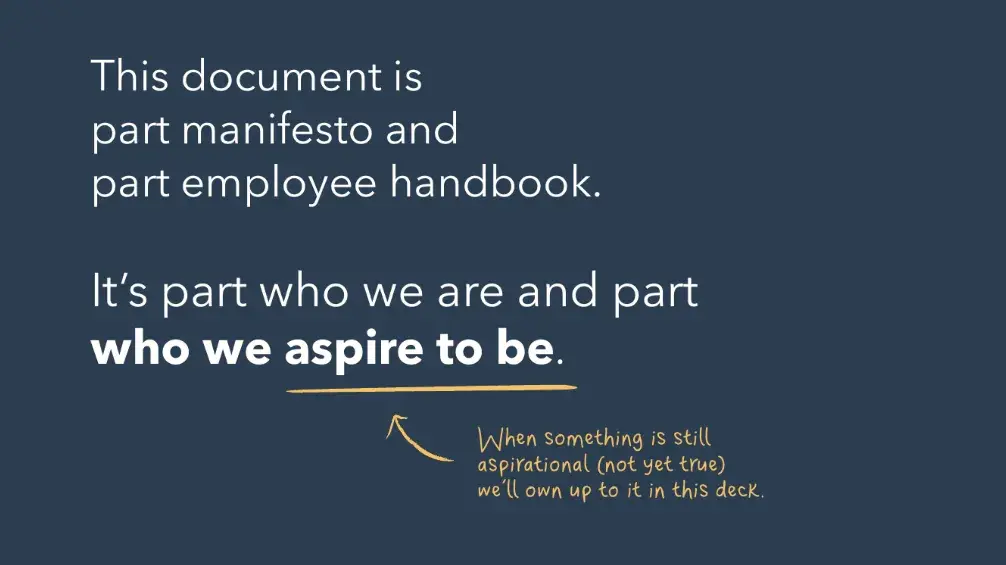
Since the Culture Code is 128 slides, there’s a quick summary of the tenets on slide 17. Not only does this function as a sort of table of contents, but it also works as a set of company values that will be influential.
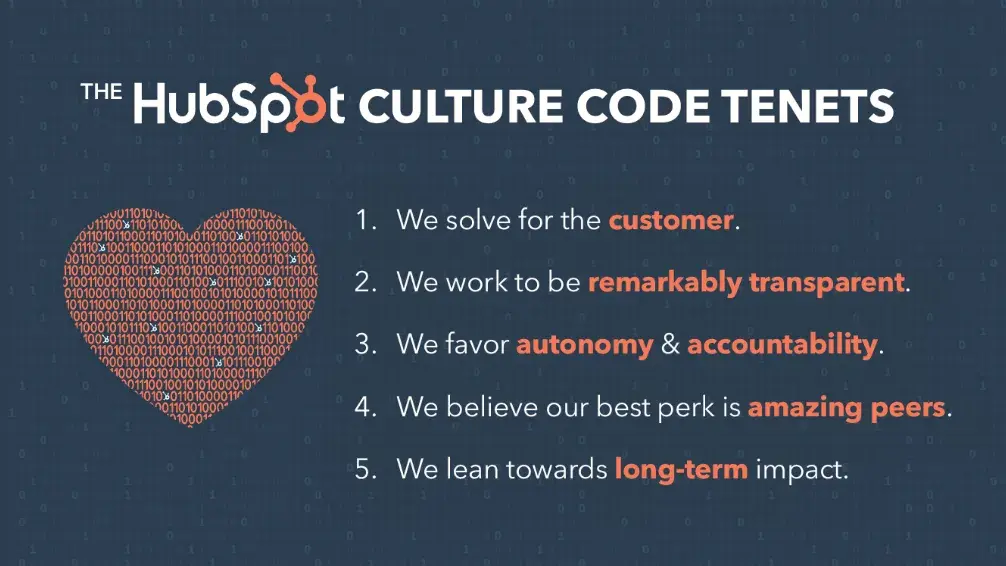
The HubSpot Culture Code seamlessly combines important policies and information for new hires with motivational, innovative messages. It conveys key legal and cultural points in the same presentation.
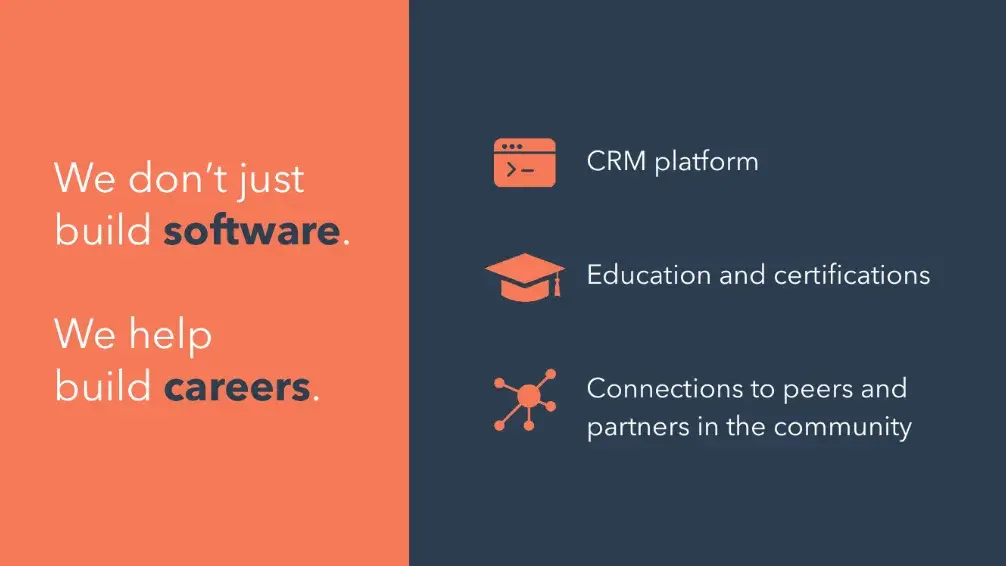
For instance, in the slide shown above, new hires receive explicit information about career development opportunities available at the company.
This aligns with the Performance and career development policies mentioned above while being reassured that HubSpot prioritizes career growth just as much as its products.
I’m also a big fan of short, clear mottos that are easy to recall and apply to several challenging situations. Things can get complex in a new job, so connecting a problem to the basics can help new hires put their work into perspective.
You can see this concept exemplified in the following slide.
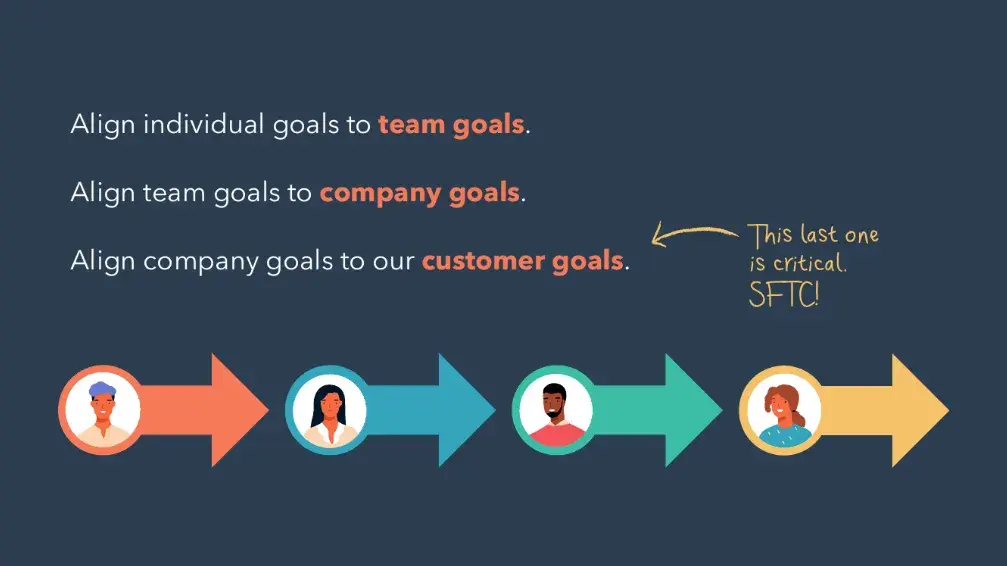
Now that I’ve walked through some powerful employee handbook samples, read on for code of conduct samples.
Code of Conduct Samples
The code of conduct, which follows the company overview section of an employee handbook, is largely important and equally as difficult to craft from scratch.
That’s why I’ve included some real examples of successful and inspiring codes of conduct:
More Than a Handbook
I’ve never considered how essential an employee handbook can be. I’ve referred to many of mine before for understanding my rights and responsibilities.
However, working on this post taught me that an employee handbook also offers the opportunity to brand one of the first documents new hires touch.
It’s an opportunity to share a company’s personality and what makes it an amazing place to work. Your new hire had the chance to impress you — now it’s your opportunity to impress them.
Editor’s note: This post was originally published in December 2018 and has been updated for comprehensiveness.




